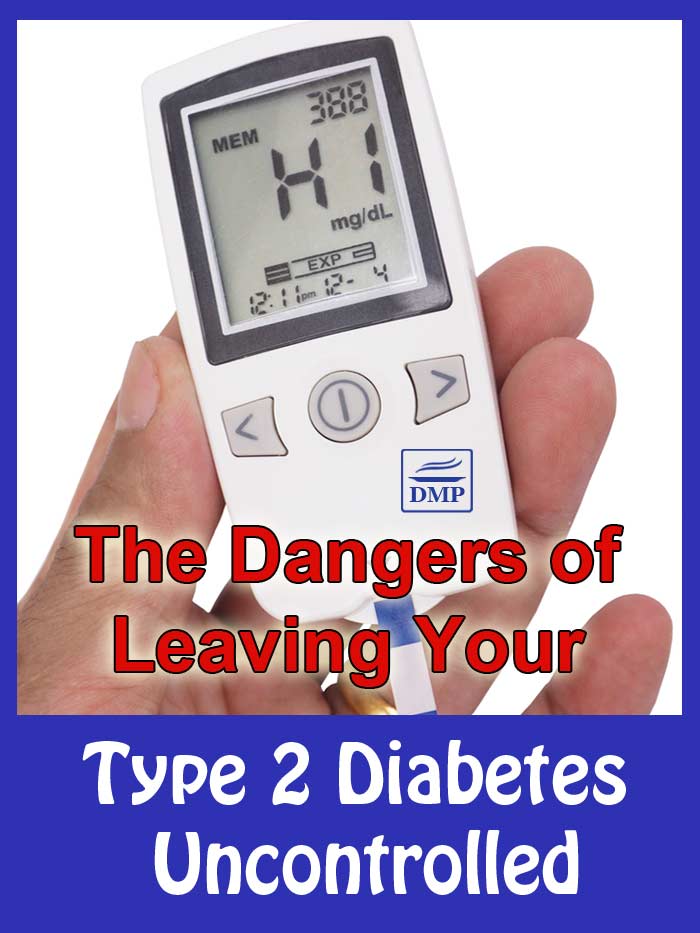You’re sitting at the doctors office with the bad news of a type 2 diabetes diagnosis and you vaguely remember the doctor saying something about the risks of being uncontrolled.
At a time like this, with your head already reeling, it can be hard to take anything in.
And even if you’ve had type 2 diabetes for sometime, it can be easy to stick your head in the sand and ignore the reality of leaving your type 2 diabetes uncontrolled.
While we don’t like to get all doom and gloom, it is important that we have this important discussion – because your very life may depend upon it!
Please read the following information carefully…

What Does ‘Uncontrolled’ Mean?
Uncontrolled diabetes is when your blood sugar and/or A1c levels are consistently above the recommended healthy ranges.
Normal blood sugar is:
- Fasting glucose – 70-99 mg/dl or 4-6 mmol/l (Note: there is some debate about the normal range in mmol/l, ranging from 5.5 to 6 mmol/l)
- 2 hours post meal glucose – Less than 140 mg/dl or less than 7.8 mmol/l
The recommended fasting target ranges may vary slightly, for instance:
- Between 70-100 mg/dL or 4-5.6 mmol/l (optimal)
- 70-110 mg/dL or 4-6 mmol/l (still good control)
- 70-130 mg/dL or 4-7.2 mmol/l (more liberal, but realistic for many)
For A1c, use the following charts as a guide:


Note: the American Diabetes Association suggests 180 (10) as the 2 hour post-meal blood sugar target for people with type 2 diabetes. And an A1c of 7%.
However, your health will be even better off if you can lower your levels as close to “normal” as possible, which is under 140 (7.8) 2-hr post-meal, and under 6% for A1c.
Let’s put the idea of being ‘uncontrolled’ into a real-life scenario…
If you’re still drinking soda, eating donuts or sitting down to a big bowl of pasta for dinner, then chances are your diabetes is uncontrolled or poorly controlled. After a meal your levels may be spiking up above 140, even above 180, right up to the 300s and 400s – this is uncontrolled.
It may also be that you’re just relying on metformin or other diabetes medications without doing anything else, such as changing your diet and lifestyle. And in this scenario, the medications will help somewhat, but your levels may be poorly controlled. For instance, your blood sugar levels are all over the place, or they are constantly higher-than-normal, especially after a meal.
The Consequences of Type 2 Diabetes Uncontrolled
Cardiologist Dr. Adam Splaver from NanoHealth Associates, suggests that the consequences of leaving your type 2 diabetes uncontrolled are very serious!
In fact, Dr. Splaver shared the following list of potential long-term complications that you’re at higher risk of acquiring:
- heart attack
- stroke
- high blood pressure
- peripheral vascular disease
- peripheral neuropathy (nerve damage)
- kidney disease or kidney failure (needing dialysis)
- non-healing ulcers/wounds (that need surgical debridement/amputation)
- diabetic retinopathy (vision problems and loss of sight)
- possibly Alzheimer’s disease
And if you’re wondering how worried you should be about these complications…
“If heart attack, stroke, pain, amputation, infections and even death are something you don’t want to experience, then you need to take your health very seriously,” says Dr. Splaver.
What this means is that getting your blood sugar levels down is of critical importance!
What Causes the Damage & Complications?
Right now you might be thinking of all those complications and wondering what causes them.
To put it simply, it’s the higher-than-normal blood sugar levels!
It’s the excess glucose in the bloodstream that leads to damage of the blood vessels throughout your body.
Think about this a little closer for a sec: blood is the source of life, carrying oxygen and nutrients to every cell, organ and part of the body to ensure optiomal function.
“As blood sugars rise, blood vessels become damaged,” says Dr. Splaver. “This causes damage to the tiniest of vessels of the body, and essentially what happens is this ‘gums up the works,’ preventing vital nutrients getting to the organs they supply.”
This just emphasizes the main goal for you: work on getting your blood sugar levels well controlled.
And if you have prediabetes, the same applies to you, too.
Please pin, tweet or share this info; then keep on reading.

How to Get Blood Sugar & A1c Levels Controlled
Lifestyle Changes
Evaluate your current lifestyle habits and ask yourself, what can I change to lead a healthier lifestyle?
We all have bad habits, some of us more than others. And while habits are certainly a challenge to change, they can be changed. The key is to be proactive and little by little with every small change you make, your health continuously improves.
Don’t just go ‘on a diet’ or do exercise for a week – put yourself as a priority and make ‘healthy’ your new way of living!

Weight Loss
Weight loss isn’t directly connected to lower blood sugar, but as an offset of losing weight, your overall metabolism improves.
For instance, one of the major benefits is your body has less inflammation, which can influence hormones and how they function, allowing your cells to communicate better.
Since diabetes is often a condition of altered metabolism, weight loss can re-alter the metabolism in a positive direction, and therefore, impacts blood sugar levels, too.
Physical Activity
Our bodies are made to move so doing any form of regular exercise is important.
Aiming for 30 minutes most days of the week is best, but even 10 minutes is better than nothing.
In terms of blood glucose improvements, exercise reduces insulin resistance by sensitizing your cells, and this helps your body clear glucose out of the bloodstream more effectively.
Exercise has a direct impact on helping to control blood sugar levels, so factoring some ‘me’ time into your day is essential.
Dietary Changes
It is absolutely critical that you eat a healthy diet – critical!
The food you eat has a direct impact on your blood sugar and A1c levels, on your metabolic function, on every single hormone, cell, and organ in your body.
Quite simply, the food you eat is the fuel for your entire body, filled with the essential vitamins, minerals, and other nutrients you need to be your best in everyday life.
While the human body can tolerate a lot, a poor diet can harm your body, leading to dysfunction and disease over time.
On the other hand, a healthy diet can heal your body and help repair and reverse the dysfunction, damage and disease, over time.

We encourage a low carb diet for two reasons:
- Carbohydrates are the nutrient that has the greatest impact on blood sugar. And while the type of carbohydrate you eat is important, the overall amount has the greatest impact on your day-to-day levels.
- Because research shows it can provide great outcomes for you. And the results of our members and subscribers show it works, too!
To get started eating a healthier diet, refer to the following resources:
If you have no idea where to start, you might consider joining the 30 Day Turnaround Program – it will take you step-by-step through good nutrition and provide plenty of food options and alternatives. And it will help clear up any confusions so you know how to take charge of your health.
If you need further support to eat well, get weekly meal plans delivered to your inbox – you don’t ever have to feel deprived or be stuck for a tasty idea!
Do Regular Blood Sugar Tests
Your A1c test is a blood test your doctor will order from once to 4 times per year. It’s a good indicator of blood glucose control because it doesn’t get influenced by your breakfast or lunch but gives you an average of the past 3 months glucose in your bloodstream.
It’s also recommended you do regular blood sugar tests at home.
As Cheryl advises (one of our members who’s had great success):
“If there is one bit of advice I would give to someone who needs to stay motivated to eat correctly, it would be to get a blood sugar monitor and use it. You will know that you are in control. What you eat makes all the difference and it will be reflected in the number you see each day on your monitor.”
Monitoring your levels can help you understand your body and how the food, stress, exercise and your overall lifestyle affect you. It gives you direct feedback so you can change your habits to lower your levels. And you will see the results of your efforts reflected in your numbers – those numbers don’t lie!
To test this theory yourself, give this method of “monitoring in pairs” a try:
To monitor in pairs, check your levels before, then 2 hours after a meal. It’s a great way to get an indication of the effect of foods and the amount of carbs you’re consuming.
For instance, one morning for breakfast have some egg muffins or a veggie filled omelet – a lower-carb meal. The next day eat breakfast cereal (such as oatmeal) and toast – a high-carb meal.
Log your numbers before and after breakfast for both days and compare the results. How do they compare? Which day is higher?
You will soon see by the numbers that your daily food intake and lifestyle habits influence your numbers. And you will soon see patterns emerging so you can then make the necessary adjustments to improve your results.
Remember, being uncontrolled isn’t really an option. Take care of yourself and strive to improve those numbers!
Please pin, tweet or share this info to help others – thanks!

Leave a Reply